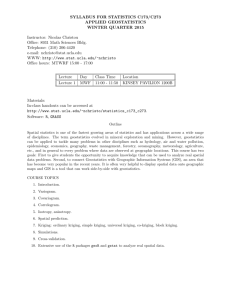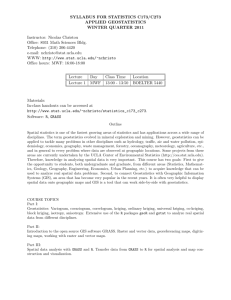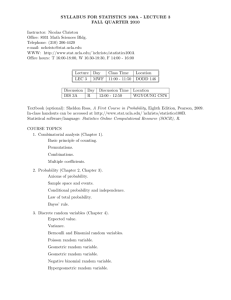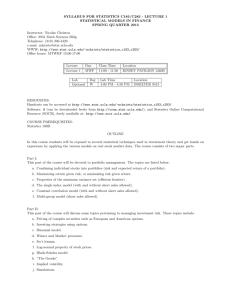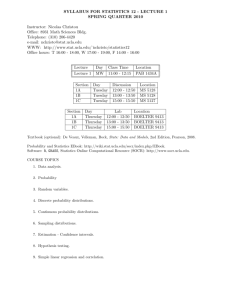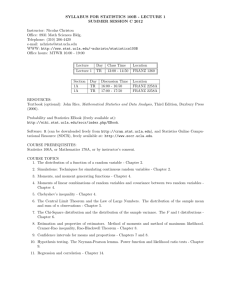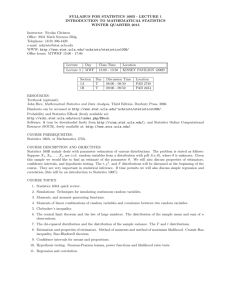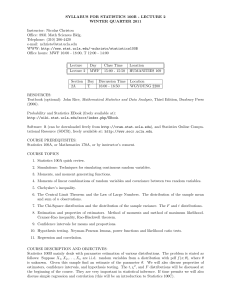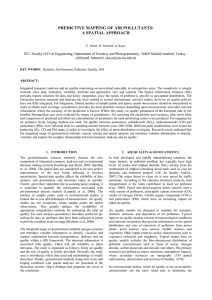SYLLABUS FOR STATISTICS C173/C273 APPLIED
advertisement
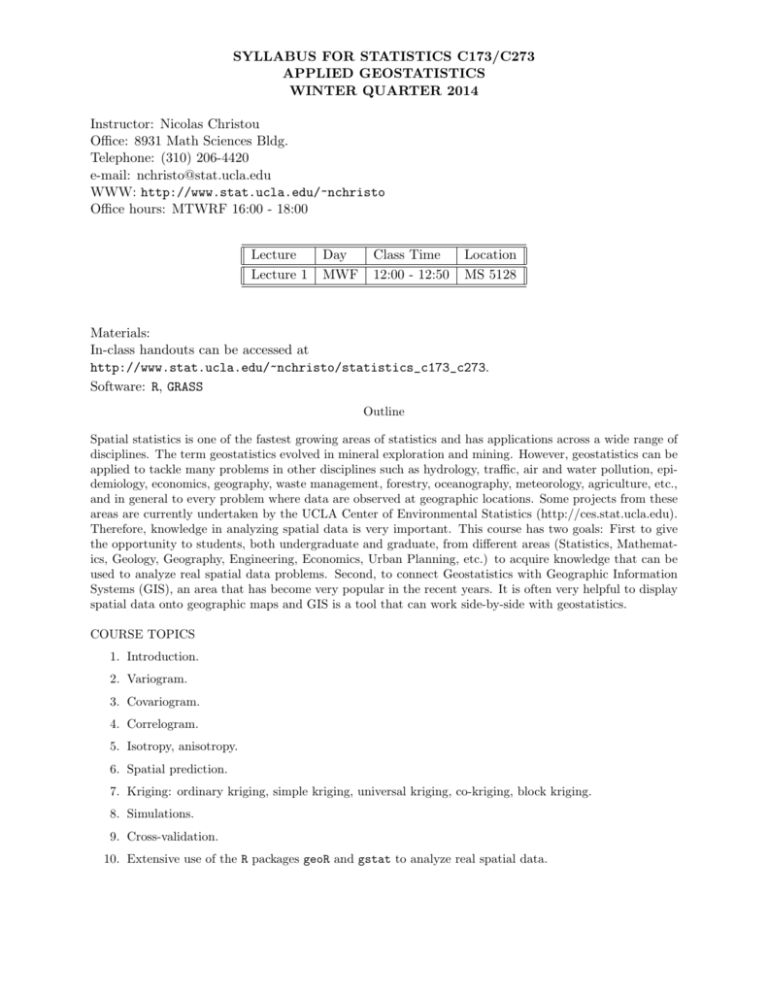
SYLLABUS FOR STATISTICS C173/C273 APPLIED GEOSTATISTICS WINTER QUARTER 2014 Instructor: Nicolas Christou Office: 8931 Math Sciences Bldg. Telephone: (310) 206-4420 e-mail: nchristo@stat.ucla.edu WWW: http://www.stat.ucla.edu/~nchristo Office hours: MTWRF 16:00 - 18:00 Lecture Lecture 1 Day MWF Class Time 12:00 - 12:50 Location MS 5128 Materials: In-class handouts can be accessed at http://www.stat.ucla.edu/~nchristo/statistics_c173_c273. Software: R, GRASS Outline Spatial statistics is one of the fastest growing areas of statistics and has applications across a wide range of disciplines. The term geostatistics evolved in mineral exploration and mining. However, geostatistics can be applied to tackle many problems in other disciplines such as hydrology, traffic, air and water pollution, epidemiology, economics, geography, waste management, forestry, oceanography, meteorology, agriculture, etc., and in general to every problem where data are observed at geographic locations. Some projects from these areas are currently undertaken by the UCLA Center of Environmental Statistics (http://ces.stat.ucla.edu). Therefore, knowledge in analyzing spatial data is very important. This course has two goals: First to give the opportunity to students, both undergraduate and graduate, from different areas (Statistics, Mathematics, Geology, Geography, Engineering, Economics, Urban Planning, etc.) to acquire knowledge that can be used to analyze real spatial data problems. Second, to connect Geostatistics with Geographic Information Systems (GIS), an area that has become very popular in the recent years. It is often very helpful to display spatial data onto geographic maps and GIS is a tool that can work side-by-side with geostatistics. COURSE TOPICS 1. Introduction. 2. Variogram. 3. Covariogram. 4. Correlogram. 5. Isotropy, anisotropy. 6. Spatial prediction. 7. Kriging: ordinary kriging, simple kriging, universal kriging, co-kriging, block kriging. 8. Simulations. 9. Cross-validation. 10. Extensive use of the R packages geoR and gstat to analyze real spatial data. COURSE POLICIES: Please remember to turn off cell phones. The use of laptop computers will not be permitted in class. You are expected to adhere to the honor code and code of conduct. If you have a disability that will require academic accommodation, please contact the UCLA Office for Students with Disabilities (OSD). ACADEMIC INTEGRITY: As a student and member of the University community, you are here to get an education and are, therefore, expected to demonstrate integrity in your academic endeavors. All students must uphold University of California Standards of Student Conduct as administered by the Office of the Dean of Students. Students are subject to disciplinary action for several types of misconduct, including but not limited to: cheating, multiple submissions, plagiarism, prohibited collaboration, facilitating academic dishonesty, or knowingly furnishing false information. You may have assignments or projects in which you work with a partner or with a group. For example, you are welcome, and even encouraged, to work with others to solve homework problems. Even though you are working together, the assignment you submit for a grade must be in your own words, unless you receive specific instructions to the contrary. For more information about academic integrity, please go to http://www.deanofstudents.ucla.edu/. COURSE GRADES: There will be three (3) midterm exams, homework or labs that will be assigned every week, and a final project on a data set of your choice. Please staple your homework or labs and write your name on them. Late homework or labs will not be accepted. Being in class on time and fully participating is important for your understanding of the material and therefore for your success in the course. You are required to attend all the lectures. Attendance will be taken during the course and it will count for 5% of your grade. The tentative dates for the exams are shown below. Final Project: Each student will select a spatial data set from an area of interest to analyze using the techniques learned in class. The course grade will be based on the calculation F inal score = + 0.05 × Attendance + 0.10 × Homework/Labs + 0.15 × P roject 0.20 × Exam1 + 0.25 × Exam2 + 0.25 × Exam3 COMMUNICATION: Please keep a current e-mail address with my.ucla.edu in order to receive class announcements and reminders. Important dates: First day of classes: 06 January. Last day of classes: 14 March. Holidays: 20 January (Martin Luther King, Jr.), 17 February (Presidents’ Day). Exams: Exam 1: Friday, 07 February, 12:00 - 12:50. Exam 2: Friday, 28 February, 12:00 - 12:50. Exam 3: Friday, 14 March, 12:00 - 12:50. Good Luck !!!
